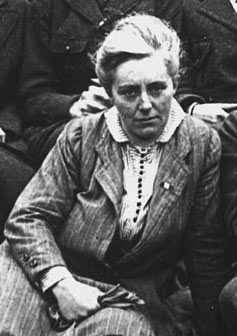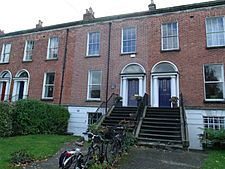Madeleine ffrench-Mullen facts for kids
Quick facts for kids
Madeleine ffrench-Mullen
|
|
|---|---|

Madeleine ffrench-Mullen c. 1917
|
|
| Personal details | |
| Born | 30 December 1880 Malta |
| Died | 26 May 1944 (aged 63) Dublin, Ireland |
| Nationality | Irish |
| Occupation | Labour activist |
| Military service | |
| Allegiance | Irish Citizen Army |
| Rank | Lieutenant |
| Battles/wars | Easter Rising |
Madeleine ffrench-Mullen (born December 30, 1880 – died May 26, 1944) was an important Irish revolutionary and activist. She worked for better conditions for workers and took part in the Easter Rising in Dublin in 1916.
Madeleine was a member of a group called Inghinidhe na hÉireann, which was a nationalist women's organisation. During the Dublin Lock-out in 1913, she helped by working in a soup kitchen at Liberty Hall. Later, she joined the Irish Citizen Army (ICA). During the Easter Rising, she helped people by working in a first-aid tent. She was arrested after the Rising but was let go the next month. She then joined Sinn Féin and was chosen to be part of the Rathmines District Council in 1920.
Contents
Early Life of Madeleine ffrench-Mullen
Madeleine ffrench-Mullen was born on December 30, 1880, in Malta. Her father, St Lawrence ffrench-Mullen, was a surgeon in the Royal Navy and was working there at the time. She had two younger brothers, St Lawrence Patrick Joseph and Douglas.
Fighting for Women's Rights
Madeleine ffrench-Mullen became interested in politics when she was young. Her father supported Charles Stewart Parnell, a famous Irish leader, and their home in Dundrum was often used for political campaigns. Madeleine believed strongly in equal rights for women and for Ireland to be a republic.
Like many women at that time, she felt it was very important for women to have the right to vote. She joined the suffrage movement, which worked to get women this right. Here, she met other women who shared her strong beliefs.
Madeleine also joined Inghinidhe na hÉireann, a women's group started by Maud Gonne in 1900. This group later became Cumann na mBan in 1913. Members of Cumann na mBan believed that women should stand equally with men in the fight for an independent Irish Republic. Madeleine was also part of the socialist movement, which believed in social equality for everyone, following the ideas of James Connolly and the Irish Citizen Army.
Madeleine ffrench-Mullen and the 1916 Easter Rising
During the Easter Rising in 1916, Madeleine ffrench-Mullen was a lieutenant in the Irish Citizen Army. She was involved in the fighting around St Stephen's Green and the Royal College of Surgeons.
In St Stephen's Green, she was in charge of 15 women from the Citizen Army. They set up a medical station to help the injured and a kitchen to feed the fighters. While they were in St Stephen's Green, they faced heavy gunfire from the Shelbourne Hotel and other buildings nearby.
After the fighters at the College of Surgeons surrendered, Madeleine ffrench-Mullen was one of 77 women who had fought in the Rising and were sent to prison. Her close friend Kathleen Lynn was also among them. Madeleine was moved to different prisons, including Richmond Barracks, Kilmainham Gaol, and Mountjoy Jail. She was finally released on June 5, 1916.
Madeleine ffrench-Mullen and Kathleen Lynn's Partnership
Madeleine ffrench-Mullen first met Kathleen Lynn through the Inghinidhe na h-Éireann group. In 1915, Madeleine moved into Kathleen's home on Belgrave Road, Rathmines. They lived together for 30 years, until Madeleine's death in 1944.
In her prison diary from 1916, Madeleine wrote that she could face prison without fear as long as she and "the Doctor" (Kathleen Lynn) were together. They were very close friends and colleagues who shared their lives and worked together on many important projects. They were part of a group of women in Dublin who met through the suffrage movement and later became involved in movements for Irish independence and workers' rights.
Legacy: St Ultan's Children's Hospital
In 1919, Madeleine ffrench-Mullen and Kathleen Lynn started Saint Ultan's Children's Hospital, also known as Teach Ultan. This was a hospital run by women for babies and young children in Dublin. The hospital focused on keeping children healthy and well, which was seen as a very important area for women to work in at the time.
A serious lung disease called Tuberculosis (TB) was very common in Ireland when it was under British rule. Even though the government and the Catholic Church were against it, Lynn and ffrench-Mullen started a special project to vaccinate children. They gave vaccines to thousands of poor children who might have died from TB without their help. Their amazing success led to Ireland's national BCG program, which has given vaccines to all babies since the 1950s.
Death
Madeleine ffrench-Mullen passed away in a nursing home in Dublin on May 26, 1944, when she was 63 years old. She is buried with her parents and younger brothers in the ffrench-Mullen family plot at Glasnevin Cemetery. Her funeral happened on the same day as the 1944 General Election in Ireland.




